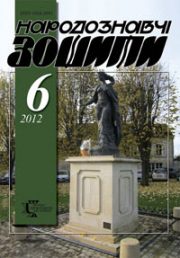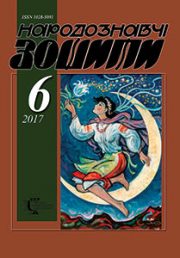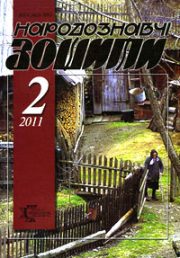The Ethnology Notebooks. 2019, № 5 (149), 1045—1055
UDK 37.091.011.3:94-051
DOI https://doi.org/10.15407/nz2019.05.1045
SOKIL Vasyl
ORCID ID: http://orcid.org/0000-0003-3164-1217
PHD in Philology, professor,
Head of the Department of Folklore Studies
at the Institute of Ethnology
of the National Academy of Sciences of Ukraine
15, Svobody Avenue, Lviv, 79000,Ukraine
e-mail: ina@mail.lviv.ua
Abstract. The publication presents the genealogy of the author, which has been maintained for over two hundred and eighty years. The genealogical research is carried out on four lines: parental (male and female) and maternal (also two lines). For the first time, evidence is introduced of the dynamics, the continuity of the family, the names of the godparents, witnesses, and priests who provided this information.
The subject of the study is the genealogical tree of a large family from its vast roots and various subsequent branches. The purpose of the study is to present the sources (which are metric records of births, marriages, and deaths of people, soil metrics, etc.), to show the invincibility of the family, which actualizes the chosen topic. This is an example of a scientific approach for those who would like to find out their genetic origins.
The manuscript documents in the Central State Historical Archive in Lviv and the record books of data on the inhabitants of Volosianka from the beginning of the ХІХ — the first half of the ХХ century, which is kept in the local church archive, served as the source for the proposed study. Only certain information is directly obtained from personal passport data.
The Sokol family on the male line was traced the deepest — since 1730’s. It was observed that the spelling of the surname was phonetically different: Sokiw, Sokoliw, Sokolуv, Sokol. Eight generations were established. There is a little less information on the female line — Liubasakh, due to the fact that grandmother Anna after her marriage moved to the Sokols.
The Hubal lineage on the maternal (male) line has been recorded since the end of the XVIII century, and five generations were discovered until mother Anastasiia moved to the Sokols. The female maternal line has been drawn from the Sidorchak family since the beginning of the ХІХ century. Grandmother Paraskeviia joined the Hubal family after her marriage at the end of the 20’s of the ХХ century.
The analysis of the metric data gives grounds for claiming that the whole family on four lines came from Volosianka; occasionally there were natives of Khashchovanya, Yalynkuvate, Rozhanka, Ternavka of Lviv region, rarely from Transcarpathia. By nationality, they were Ukrainians; according to the religion, they were of the Greek-Catholic rite. The only exception is Anna Furiv (Sidorchak family) whose mother is a daughter of Habriel Skolskyi; she was christened in Skole according to the Latin rite.
According to metric records, the names of the priests are established: Hryhorii Ruzhylovych, Ivan Makarevych, Ivan Rakovskyi, Ivan Revakovych, Mykhailo Revakovych, Petro Karvatskyi, Ivan Dorka, Vasyl Shakh, Mykhailo Haiduk, Ivan Levytskyi.
To visualize and elaborate the genealogical information, a diagram is provided that summarizes the presented material.
Keywords: genealogy, male, maternal line, godparent, witness, priest.
Received 12.08.2019
REFERENCES
The Josephine metric. Soil metrics, detailed descriptions of land boundaries, rules for the fielding of cornfields, summaries and other documents. s. Volosyanka. 1786–1788. In Tsentral’nyy derzhavnyy istorychnyy arkhiv u L’vovi (dali TSDIA). F. 19. Op. 16. Od. zb. 39. 183 ark. [in Ukrainian].
The Metric Book of Death. s. Volosyanka. 1812–1855. In TSDIA u L’vovi. F. 201. Op. 4 a. Od. zb. 938. 49 ark. [in Ukrainian].
Franciscan metric. Detailed metrics of land profit, description of land borders. s. Volosyanka. 1789–1820. In TSDIA u L’vovi. F. 20. Op. 16. Od. zb. 204. 131 ark. [in Ukrainian].
Metric marriage book. s. Volosyanka.1812–1860. In TSDIA u L’vovi. F. 201. Op. 4 a. Od. zb. 939. 51 ark. [in Ukrainian].
Metric Birth Book. s. Volosyanka. 1830–1881. In TSDIA u L’vovi. F. 201. Op. 4 a. Od. zb. 940. 49 ark. [in Ukrainian].
Metric book. s. Volosyanka. 1843–1857 rr. In TSDIA u L’vovi. F. 201. Op.4 a. Od. zb. 943. 71 ark. [in Ukrainian].
Metric Book (Birth, Marriage, Death). s. Volosyanka. The beginning of the nineteenth – first half of the twentieth century.In Parokhial’nyy arkhiv s. Volosyanky. 260 ark. [in Ukrainian].
Metric Book (Birth, Marriage, Death). s. Volosyanka. 1866–1905. In TSDIA u L’vovi. F. 201. Op. 4 a. Od. zb. 6359. 312 ark. [in Ukrainian].
Metric Book (Birth, Marriage, Death). s. Volosyanka. 1906–1930. In TSDIA u L’vovi. F. 201. Op.4 a. Od. zb. 7707. 201 ark. [in Ukrainian].
Metric Birth Book. s. Volosyanka. 1812–1830. In TSDIA u L’vovi. F. 201. Op. 4 a. Od. zb. 937. 47 ark. [in Ukrainian].
Metric Book. s. Volosyanka. 1840–1864. In TSDIA u L’vovi. F. 201. Op.4 a. Od. zb. 942. 67 ark. [in Ukrainian].
Metric Book. (сopi). s. Volosyanka. 1837–1865. In TSDIA u L’vovi. F. 201. Op.4 a. Od. zb. 941. 66 ark. [in Ukrainian].






